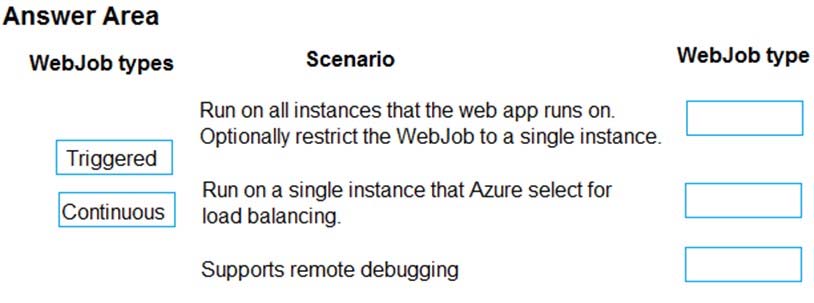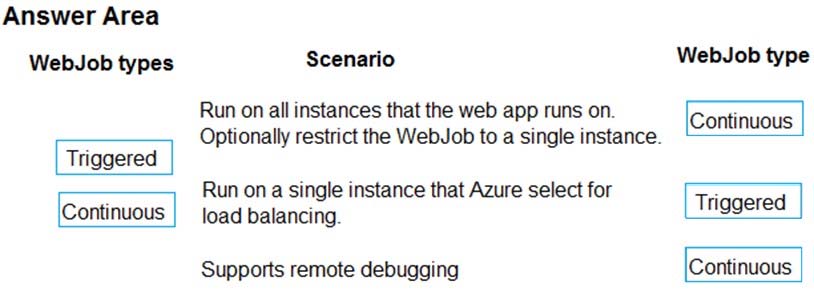

HOTSPOT -
You have an Azure Batch project that processes and converts files and stores the files in Azure storage. You are developing a function to start the batch job.
You add the following parameters to the function.
You must ensure that converted files are placed in the container referenced by the outputContainerSasUrl parameter. Files which fail to convert are placed in the container referenced by the failedContainerSasUrl parameter.
You need to ensure the files are correctly processed.
How should you complete the code segment? To answer, select the appropriate options in the answer area.
NOTE: Each correct selection is worth one point.
Hot Area:
Correct Answer:
Explanation
Box 1: CreateJob -
Box 2: TaskSuccess -
TaskSuccess: Upload the file(s) only after the task process exits with an exit code of 0.
Incorrect: TaskCompletion: Upload the file(s) after the task process exits, no matter what the exit code was.
Box 3: TaskFailure -
TaskFailure:Upload the file(s) only after the task process exits with a nonzero exit code.
Box 4: OutputFiles -
To specify output files for a task, create a collection of OutputFile objects and assign it to the CloudTask.OutputFiles property when you create the task.
References:
https://docs.microsoft.com/en-us/dotnet/api/microsoft.azure.batch.protocol.models.outputfileuploadcondition https://docs.microsoft.com/en-us/azure/batch/batch-task-output-files
You are writing code to create and run an Azure Batch job.
You have created a pool of compute nodes.
You need to choose the right class and its method to submit a batch job to the Batch service.
Which method should you use?
Correct Answer:
E
🗳️
A Batch job is a logical grouping of one or more tasks. A job includes settings common to the tasks, such as priority and the pool to run tasks on. The app uses the
BatchClient.JobOperations.CreateJob method to create a job on your pool.
The Commit method submits the job to the Batch service. Initially the job has no tasks.
{
CloudJob job = batchClient.JobOperations.CreateJob();
job.Id = JobId;
job.PoolInformation = new PoolInformation { PoolId = PoolId }; job.Commit();
}
...
References:
https://docs.microsoft.com/en-us/azure/batch/quick-run-dotnet
DRAG DROP -
You are developing Azure WebJobs.
You need to recommend a WebJob type for each scenario.
Which WebJob type should you recommend? To answer, drag the appropriate WebJob types to the correct scenarios. Each WebJob type may be used once, more than once, or not at all. You may need to drag the split bar between panes or scroll to view content.
NOTE: Each correct selection is worth one point.
Select and Place:
Correct Answer:

Box 1: Continuous -
Continuous runs on all instances that the web app runs on. You can optionally restrict the WebJob to a single instance.
Box 2: Triggered -
Triggered runs on a single instance that Azure selects for load balancing.
Box 3: Continuous -
Continuous supports remote debugging.
Note:
The following table describes the differences between continuous and triggered WebJobs.
References:
https://docs.microsoft.com/en-us/azure/app-service/web-sites-create-web-jobs
You are developing a software solution for an autonomous transportation system. The solution uses large data sets and Azure Batch processing to simulate navigation sets for entire fleets of vehicles.
You need to create compute nodes for the solution on Azure Batch.
What should you do?
Correct Answer:
B
🗳️
A Batch job is a logical grouping of one or more tasks. A job includes settings common to the tasks, such as priority and the pool to run tasks on. The app uses the
BatchClient.JobOperations.CreateJob method to create a job on your pool.
Note:
Step 1: Create a pool of compute nodes. When you create a pool, you specify the number of compute nodes for the pool, their size, and the operating system.
When each task in your job runs, it's assigned to execute on one of the nodes in your pool.
Step 2: Create a job. A job manages a collection of tasks. You associate each job to a specific pool where that job's tasks will run.
Step 3: Add tasks to the job. Each task runs the application or script that you uploaded to process the data files it downloads from your Storage account. As each task completes, it can upload its output to Azure Storage.
Incorrect Answers:
C, F: To create a Batch pool in Python, the app uses the PoolAddParameter class to set the number of nodes, VM size, and a pool configuration.
E: BatchClient.PoolOperations does not have a CreateJob method.
References:
https://docs.microsoft.com/en-us/azure/batch/quick-run-dotnet https://docs.microsoft.com/en-us/azure/batch/quick-run-python